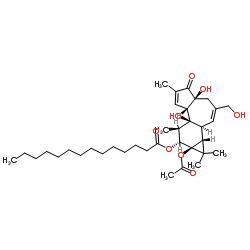4α-TPA

4α-TPA structure
|
Common Name | 4α-TPA | ||
|---|---|---|---|---|
| CAS Number | 63597-44-4 | Molecular Weight | 616.83 | |
| Density | 1.2±0.1 g/cm3 | Boiling Point | 698.1±55.0 °C at 760 mmHg | |
| Molecular Formula | C36H56O8 | Melting Point | N/A | |
| MSDS | Chinese USA | Flash Point | 208.1±25.0 °C | |
|
Differential cellular uptake and metabolism of curcuminoids in monocytes/macrophages: regulatory effects on lipid accumulation.
Br. J. Nutr. 112(1) , 8-14, (2014) We have previously shown that curcumin (CUR) may increase lipid accumulation in cultured human acute monocytic leukaemia cell line THP-1 monocytes/macrophages, but that tetrahydrocurcumin (THC), an in vivo metabolite of CUR, has no such effect. In the present... |
|
|
Protein kinase C-activating tumor promoters modulate the DNA damage response in UVC-irradiated TK6 cells.
Toxicol. Lett. 229(1) , 210-9, (2014) 12-O-Tetradecanoylphorbol-13-acetate (TPA) is a non-genotoxic tumor promoter that dysregulates the protein kinase C (PKC) pathway and causes variable cellular responses to DNA damage in different experimental models. In the present study, we pretreated human ... |
|
|
Differential 12-O-Tetradecanoylphorbol-13-acetate-induced activation of rat mammary carcinoma susceptibility Fbxo10 variant promoters via a PKC-AP1 pathway.
Mol. Carcinog. 54(2) , 134-47, (2015) Rat mammary carcinoma susceptibility 5a1 (Mcs5a1), which is concordant to human MCS5A1 breast cancer risk locus, mediates susceptibility by a non-mammary cell-autonomous mechanism associated with T cell differential expression of F-box protein 10 (Fbxo10). Hu... |
|
|
Drosophila MagT1 is upregulated by PKC activation.
Biochem. Biophys. Res. Commun. 436(2) , 140-4, (2013) Magnesium transporter subtype 1 (MagT1) is a newly discovered and evolutionarily conservative magnesium membrane transporter with channel like properties. Previous reports have demonstrated that MagT1 is important to cellular magnesium homeostasis. In this st... |
|
|
Accelerated receptor shedding inhibits kidney injury molecule-1 (KIM-1)-mediated efferocytosis.
Am. J. Physiol. Renal Physiol. 307(2) , F205-21, (2014) Efficient clearance of apoptotic cells (efferocytosis) prevents inflammation and permits repair following tissue injury. Kidney injury molecule-1 (KIM-1) is a receptor for phosphatidylserine, an "eat-me" signal exposed on the surface of apoptotic cells that m... |
|
|
Identification of protein kinase C activation as a novel mechanism for RGS2 protein upregulation through phenotypic screening of natural product extracts.
Mol. Pharmacol. 86(4) , 406-16, (2014) Biochemical high-throughput screening is widely used in drug discovery, using a variety of small molecule libraries. However, broader screening strategies may be more beneficial to identify novel biologic mechanisms. In the current study we used a β-galactosi... |
|
|
Preparation of low molecular weight fucoidan by gamma-irradiation and its anticancer activity.
Carbohydr. Polym. 97(2) , 358-62, (2013) Fucoidan is a marine sulfated polysaccharide with a wide variety of biological activities. Recently, it has been reported that low molecular weight fucoidan has the enhanced antioxidant and anticoagulative activities. However, degradation techniques such as e... |
|
|
Upregulation of membrane-bound CD40L on CD4+ T cells in women with primary Sjögren's syndrome.
Scand. J. Immunol. 79(1) , 37-42, (2014) Epigenetic deregulation of genes encoded on the X chromosome as reported for CD40L in lupus could explain the female predominance of autoimmune diseases. We compared CD40L expression on CD4(+) T cells from primary Sjögren's syndrome (pSS) women and healthy co... |
|
|
Phytosphingosine derivatives ameliorate skin inflammation by inhibiting NF-κB and JAK/STAT signaling in keratinocytes and mice.
J. Invest. Dermatol. 134(4) , 1023-32, (2014) Phytosphingosine is abundant in plants and fungi and is found in mammalian epidermis, including the stratum corneum. Phytosphingosine and its derivatives N-acetyl phytosphingosine and tetraacetyl phytosphingosine are part of the natural defense system of the ... |
|
|
New ex vivo approaches distinguish effective and ineffective single agents for reversing HIV-1 latency in vivo.
Nat. Med. 20(4) , 425-9, (2014) HIV-1 persists in a latent reservoir despite antiretroviral therapy (ART). This reservoir is the major barrier to HIV-1 eradication. Current approaches to purging the latent reservoir involve pharmacologic induction of HIV-1 transcription and subsequent killi... |